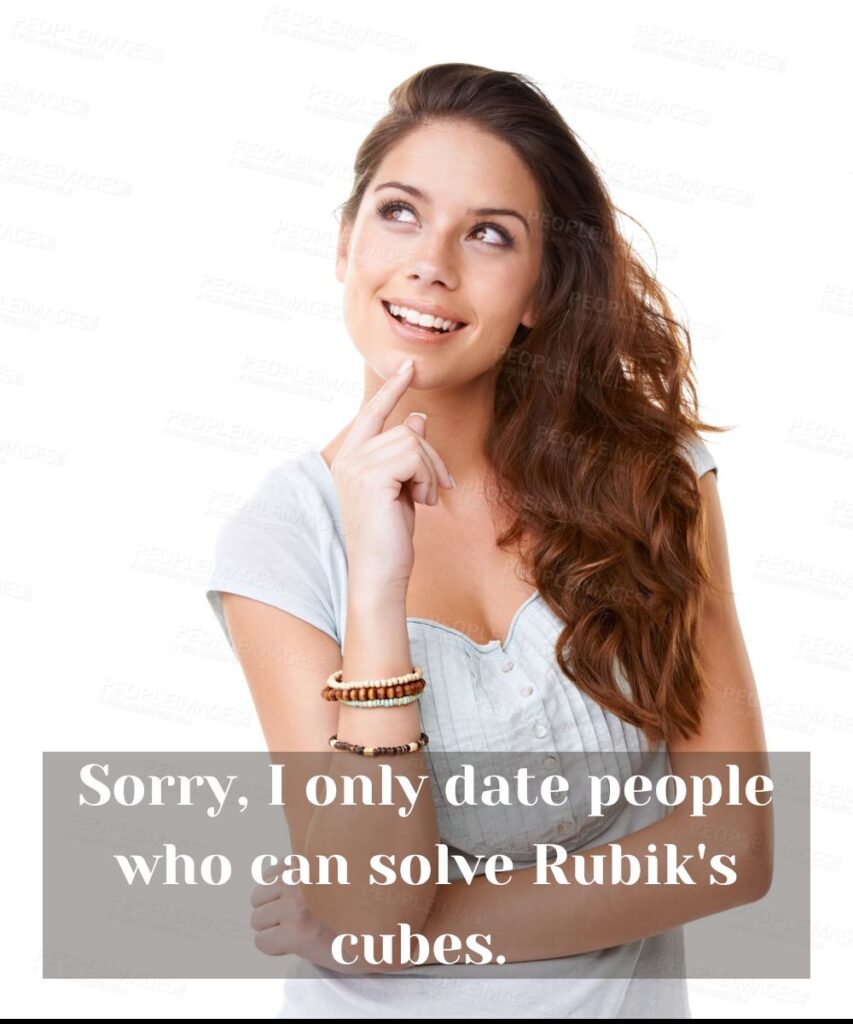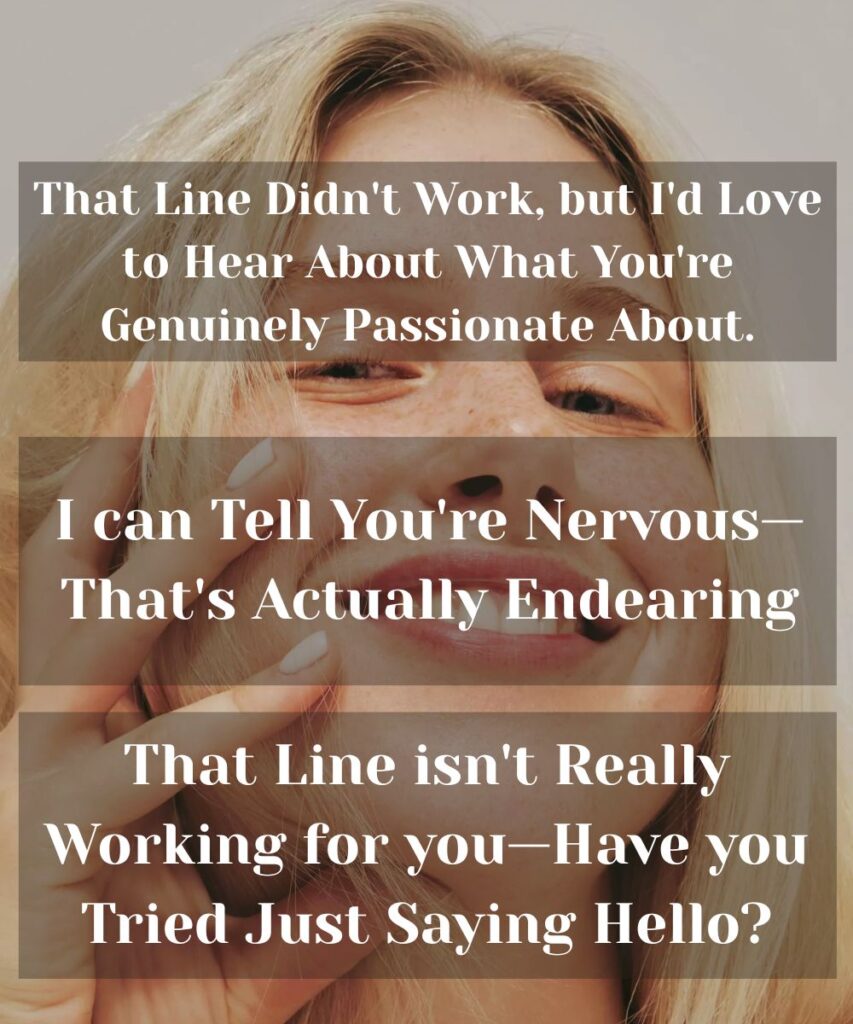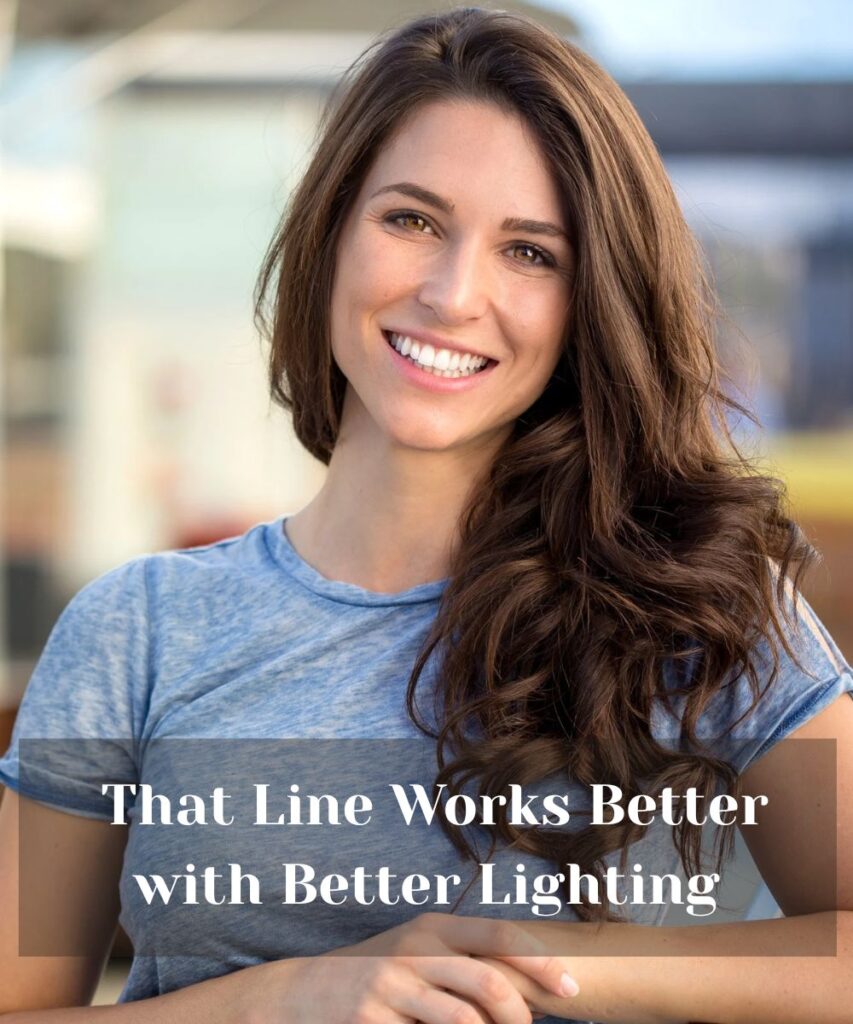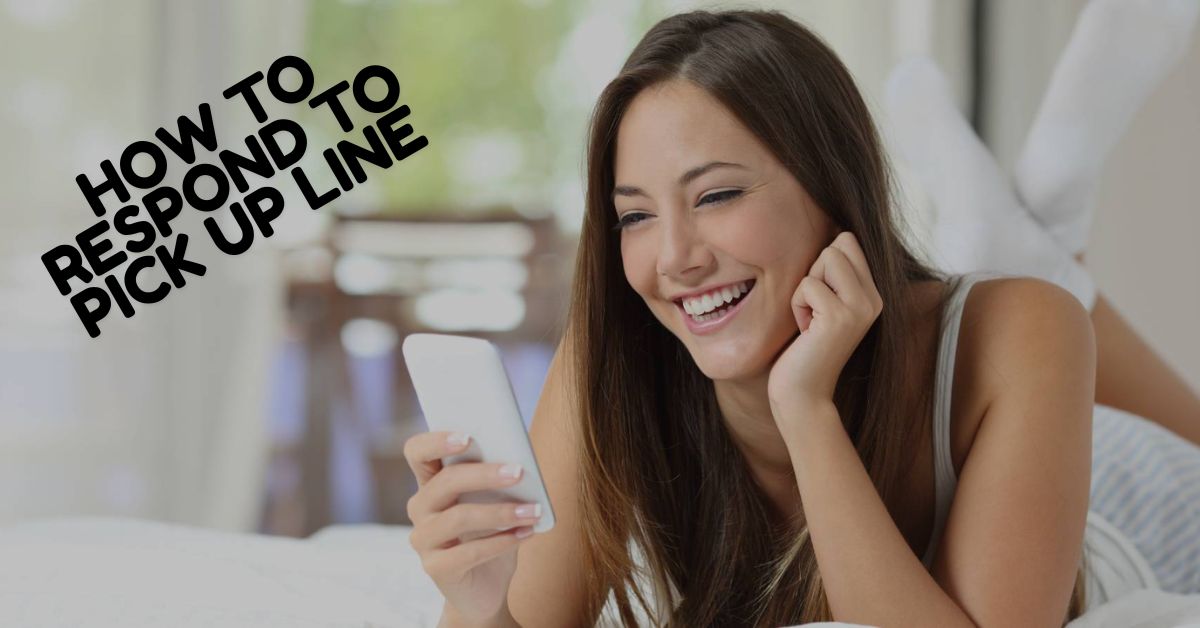Pick up lines happen everywhere—from coffee shops to dating apps—and knowing how to respond effectively can make or break these unexpected encounters.
Whether you’re dealing with charming wit or cringe-worthy attempts, your response sets the tone for what comes next.
This comprehensive guide provides over 100 proven responses that’ll help you navigate any pick up line scenario with confidence and style.
Witty and Clever Responses to Pick Up Lines

Sharp wit never goes out of style when someone approaches you with their best shot.
When someone delivers a pick up line, responding with cleverness demonstrates your quick thinking and intelligence. These responses work particularly well because they match the playful energy while showcasing your personality. Consider responses like “That’s cute, did you practice that in the mirror?” or “I’d give that line a solid 6 out of 10—points for effort though.”
Clever comebacks often involve wordplay or unexpected twists. If someone says “Are you a magician? Because whenever I look at you, everyone else disappears,” you might respond with “Actually, I’m more of an escape artist—watch me vanish.” This type of response shows you’re engaged but not easily impressed, creating intrigue rather than shutting down the conversation entirely.
The beauty of witty responses to pick up lines lies in their ability to elevate the interaction. Instead of giving a flat rejection or overly enthusiastic acceptance, you’re creating a moment of genuine connection through shared humor. Try responses like “That line worked on me… in my dreams last night” or “I’ve heard that one before, but your delivery was unique.”
For particularly creative pick up line responses, consider building on their theme. If they use a science-based line, respond with your own scientific fact. If they go with food metaphors, serve up your own culinary comeback. This demonstrates active listening while maintaining the playful atmosphere they initiated.
More Post: 195+ Harry Potter Pick Up Lines / Spell on Your Crush
Sarcastic Comebacks for Cheesy Pick Up Lines
Sometimes the cheesier the line, the more sarcasm it deserves in return.
Sarcastic responses work exceptionally well with overly rehearsed or particularly cheesy attempts. They signal that you recognize the lack of originality while keeping things light enough to continue the interaction if there’s mutual interest. Classic sarcastic comebacks include “Wow, I’ve never heard that one before” delivered with a knowing smile, or “Did you just win the creativity award?”
The key to effective sarcastic comebacks is delivery—your tone should be playful rather than harsh. Responses like “That line must work on everyone” or “I can see you’ve really thought this through” communicate your amusement at their approach without being cruel. Remember, sarcasm should entertain, not devastate.
Cheesy pick up line responses often work best when they’re slightly exaggerated. Try “Oh my goodness, that’s so original! No one has ever compared me to a parking ticket before!” This approach acknowledges the absurdity while keeping the mood light. Another effective strategy involves pretending to be genuinely impressed: “Wow, Shakespeare could never!”
For those moments when someone delivers an absolutely terrible line, sarcastic responses like “I’m calling the poetry police” or “That deserves a standing ovation… for effort” can actually create bonding moments through shared laughter at the absurdity of the situation.
How to Respond to Pick Up Lines with Humor

Laughter creates connection, making humorous responses incredibly powerful tools.
Humorous responses to pick up lines work because they immediately establish a fun, relaxed atmosphere. When someone approaches with “Do you have a map? I keep getting lost in your eyes,” you might respond with “Actually yes, it’s called GPS and it’s way more reliable than my eyes.” This type of response shows you appreciate humor while redirecting the conversation.
Funny comebacks often involve unexpected perspectives or absurd escalations. Consider responses like “That’s interesting, but have you heard about our lord and savior?” or “Sorry, I only date people who can solve Rubik’s cubes.” These responses are memorable because they’re completely unpredictable, making you stand out from typical interactions.
The secret to humorous pick up line responses lies in timing and confidence. A well-delivered “I’m flattered, but I’m actually a robot” or “That’s sweet, but I’m allergic to compliments” can transform an awkward moment into genuine laughter. Humor diffuses tension while keeping doors open for further conversation.
Self-deprecating humor can also work wonderfully: “Thanks, but you clearly need glasses” or “I appreciate the sentiment, but you might want to raise your standards.” These responses show confidence and humor while gently deflecting without being mean. They often lead to more authentic conversations because they break down pretenses immediately.
Flirty Ways to Respond to Pick Up Lines You Actually Like
When someone’s approach genuinely appeals to you, flirty responses keep the energy flowing.
Flirty responses signal genuine interest while maintaining some playful mystery. If someone delivers a line you actually appreciate, responses like “That was smooth—I’m impressed” or “Okay, you’ve got my attention” encourage them to continue while showing your approval. Positive reinforcement through flirty responses often leads to more meaningful conversations.
Engaging flirtatiously means matching their energy while adding your own twist. Try responses like “I like your confidence—what else you got?” or “That was actually pretty good—your turn to impress me further.” These responses create interactive dynamics where both parties contribute to the playful exchange.
The most effective flirty pick up line responses often involve gentle challenges or invitations for more. “Prove it” becomes a powerful response to compliment-based lines, while “I’m intrigued—tell me more” works well with clever or witty approaches. These responses maintain momentum rather than stopping the interaction cold.
Body language amplifies flirty responses—a genuine smile, maintained eye contact, or playful gesturing can transform simple words into genuine invitation. Responses like “You’re trouble, aren’t you?” or “I have a feeling you’re going to be interesting” paired with the right nonverbal cues create authentic connection opportunities.
More Post: 175+ Good Icebreaker Pick Up Lines That Actually Work in 2025
Polite Responses to Unwanted Pick Up Lines

Not every approach deserves encouragement, but maintaining politeness protects everyone involved.
Polite rejection responses serve multiple purposes: they maintain your dignity, protect the other person’s feelings, and keep situations from escalating uncomfortably. Simple responses like “That’s sweet, but I’m not interested” or “I appreciate the compliment, but no thank you” communicate clearly without creating hostility. Clear boundaries expressed kindly prevent misunderstandings.
Gentle but firm responses work particularly well in social settings where you might encounter the person again. Try “I’m flattered, but I’m here with friends tonight” or “Thanks, but I’m taking a break from dating.” These responses acknowledge their effort while firmly establishing your position. Politeness doesn’t mean obligation—you can be kind while being definitive.
For persistent individuals, escalating polite responses might be necessary. Start with “I’m not interested, but thank you” and progress to “I’ve already said no, please respect that” if needed. Maintaining politeness while being increasingly direct shows maturity and often defuses potential conflict better than immediate harshness.
Professional settings require extra diplomatic care. Responses like “I keep my personal and professional lives separate” or “I prefer to maintain workplace boundaries” communicate clearly while protecting working relationships. Context matters tremendously when crafting polite responses to unwanted advances.
Confident Responses That Show Your Personality
Your response reveals who you are—make it count by showcasing your authentic self.
Confident responses demonstrate self-assurance without arrogance. When someone approaches with a pick up line, responding with something like “I admire the confidence—not the line, but the confidence” shows you’re secure enough to appreciate boldness while maintaining your standards. Confidence attracts genuine people while deterring those seeking easy targets.
Personality-driven responses make you memorable for the right reasons. If you’re naturally funny, lean into humor. If you’re intellectually inclined, engage with clever wordplay. If you’re straightforward, be direct but warm. Authenticity resonates more than any scripted response ever could. Try “Points for creativity, but I’m more impressed by genuine conversation” if that reflects your values.
Self-assured comebacks often involve turning the dynamic around: “That’s interesting—now tell me something real about yourself” or “Cute line, but what’s your actual personality like?” These responses show you’re not easily impressed by surface-level charm and value deeper connections over clever words.
The most effective confident responses often involve gentle challenges that invite authenticity: “That was rehearsed—give me something spontaneous” or “I can see you’ve got game, but do you have substance?” Confident people seek genuine connections and aren’t afraid to push past superficial interactions to find them.
More Post: 195+ Funny St. Patrick’s Day Pick Up Lines
How to Respond to Bad Pick Up Lines Without Being Mean

Terrible lines deserve gentle handling—cruelty reflects poorly on your character.
Diplomatic responses to poor lines require balancing honesty with kindness. When faced with truly awful attempts, responses like “I can tell you’re nervous—that’s actually endearing” or “Your delivery needs work, but I appreciate the effort” acknowledge the failure while preserving dignity. Kindness costs nothing but can transform someone’s entire day.
Constructive responses can actually help people improve their approach. Try “That line isn’t really working for you—have you tried just saying hello?” or “I think you’d have better luck with genuine compliments.” Teaching moments handled gently can prevent future awkward encounters for everyone involved.
For absolutely cringe-worthy attempts, responses like “Bless your heart” (particularly effective in Southern contexts) or “That’s… certainly bold” acknowledge the attempt without either endorsing or destroying it. Grace under pressure demonstrates character and often leads to more authentic interactions once the pretense drops.
Redirecting bad lines toward genuine conversation works wonderfully: “That line didn’t work, but I’d love to hear about what you’re genuinely passionate about.” This approach transforms failures into opportunities for real connection, showing maturity and emotional intelligence that many people find attractive.
Creative Responses to Common Pick Up Lines
Standard lines deserve upgraded responses that showcase your originality.
Creative comebacks to overused lines demonstrate your quick thinking and originality. When someone asks “Do you believe in love at first sight, or should I walk by again?” respond with “I believe in good conversation—try that first.” Originality stands out in a world of recycled approaches and shows you’re worth the extra effort.
Innovative responses often involve completely reframing the interaction. For “Are you a camera? Because you make me smile,” try “Actually, I’m more like a photographer—I capture the real moments, not the posed ones.” Unexpected angles create memorable exchanges that people talk about later, making you unforgettable for the right reasons.
Playful redirections work particularly well with common lines. When faced with “If you were a vegetable, you’d be a cute-cumber,” respond with “If you were a spice, you’d be flour—basic but essential.” Turning their metaphor against them playfully shows wit while maintaining the fun atmosphere they attempted to create.
The key to creative pick up line responses is building on their foundation while elevating the entire interaction. Creative people attract other creative individuals, so responding with originality often filters for more interesting connections. Try “That line has potential—let’s workshop it together” for particularly adventurous moments.
More Post: 165+ Lord of the Rings Pick Up Lines
Responding to Pick Up Lines in Different Social Settings

Context determines everything—your office response differs dramatically from your club response.
Workplace responses require extra diplomatic finesse since you’ll likely encounter these people regularly. Professional responses like “I keep my work and personal life separate” or “Let’s keep things professional here” establish boundaries while maintaining working relationships. Career protection should always influence your response strategy in professional environments.
Social venues allow for more relaxed responses. In bars or clubs, playful responses like “Buy me a drink and try again” or “That line works better with better lighting” fit the casual atmosphere. Environmental awareness helps you calibrate your response appropriately—what works at a comedy club might not work at a coffee shop.
Online dating platforms create unique dynamics where written responses lack vocal tone and body language cues. Text-based responses need extra clarity: “Interesting opener—tell me something genuine about yourself” works better than sarcasm that might be misinterpreted. Digital communication requires more explicit emotional signaling.
Family or community events demand maximum diplomacy since these interactions have long-term social consequences. Responses like “That’s sweet, but let’s focus on enjoying the event” or “I appreciate the compliment, but I’m here to spend time with family” protect relationships while maintaining boundaries. Social consequences multiply in close-knit communities.
Quick One-Liner Responses to Any Pick Up Line
Sometimes brevity creates the most powerful impact of all.
Rapid-fire responses work excellently when you need immediate resolution without lengthy conversation. “Cute” delivered with a knowing smile can mean anything from genuine appreciation to gentle dismissal, depending on your tone and body language. Ambiguous responses keep your options open while buying time to assess the situation.
Punchy comebacks like “Original” (said sarcastically), “Smooth” (said genuinely), or “Interesting choice” provide quick acknowledgment while revealing nothing about your actual interest level. Economy of words often creates more intrigue than elaborate responses, leaving them wondering about your true thoughts.
Single-word responses can be incredibly effective: “Really?” “Seriously?” “Wow.” Each carries different implications but requires the other person to work harder for genuine engagement. Minimal effort responses often reveal who’s willing to put in actual work versus who expects easy success.
The beauty of quick responses lies in their versatility—the same word can encourage or discourage based entirely on delivery. Master communicators understand that tone, timing, and body language matter more than elaborate vocabulary when delivering concise responses to pick up attempts.
How to Respond to Pick Up Lines When You’re Not Interested
Clear communication prevents misunderstandings and unwanted persistence.
Direct rejection responses work best when delivered kindly but firmly. “I’m not interested, but thank you” communicates clearly without leaving room for misinterpretation. Clarity prevents follow-up attempts and awkward situations. Adding “I hope you have a great evening” softens the rejection while maintaining firmness.
Indirect rejection methods work well when you want to avoid potential confrontation. “I’m seeing someone” or “I’m not dating right now” provide easy exit strategies that most people respect. Social scripts like these are widely understood and typically accepted without argument or persistence.
Graceful exits become necessary when someone doesn’t accept initial rejection. “I need to get back to my friends” or “I should let you get back to your evening” provide natural conversation endings. Physical movement away from the person reinforces your verbal rejection and prevents extended uncomfortable interactions.
Escalation responses become necessary for persistent individuals who ignore polite rejection. “I’ve already said no” or “Please respect my answer” establish stronger boundaries. Document persistence in professional or repeated social settings, as patterns of ignoring rejection can indicate more serious problems requiring intervention.
More Post: 180+ Football Pick Up Lines
Playful Responses That Keep the Conversation Going
When someone intrigues you, playful responses maintain momentum while building connection.
Engaging playfully means matching their energy while adding your own flair. Responses like “That was bold—I like bold” or “Okay, you’ve earned five more minutes of my attention” encourage continuation while establishing that you have standards. Playful boundaries create structure within flirtation, making interactions more exciting for both parties.
Interactive responses invite collaboration rather than passive reception. Try “Your turn—impress me” or “I’ll give you another shot if you can make me laugh” to create dynamic exchanges where both people contribute actively. These responses transform monologues into genuine conversations with mutual participation.
Challenge-based responses can be incredibly effective: “Prove it,” “Show me,” or “That’s a big claim—back it up” invite the other person to move beyond surface-level charm toward substantive interaction. Playful challenges often reveal character while maintaining the fun atmosphere that makes flirtation enjoyable.
Building responses that acknowledge their effort while raising stakes work wonderfully: “That was good—what else you got?” or “Interesting start—where are you going with this?” Progressive engagement allows both parties to invest gradually, creating natural chemistry rather than forced interactions.
Professional Ways to Respond to Pick Up Lines at Work
Workplace advances require diplomatic handling that protects careers and relationships.
Professional boundary responses must be clear without creating hostile work environments. “I prefer to keep my professional and personal lives separate” communicates boundaries while maintaining respect for the person. Career protection always takes precedence over social politeness in workplace situations.
HR-appropriate responses protect you legally while handling situations diplomatically. “That’s not appropriate for work” or “Let’s keep our interactions professional” create documented boundaries if situations escalate. Professional documentation of inappropriate workplace behavior protects everyone involved and maintains proper business conduct.
Colleague relationship preservation requires extra care since you’ll continue working together. “I value our working relationship too much to complicate it” acknowledges their interest while prioritizing professional dynamics. Long-term thinking prevents awkward ongoing interactions and maintains team cohesion.
Authority dynamic considerations become crucial when the approach comes from supervisors or subordinates. Power imbalances require immediate HR involvement rather than personal handling. “I think we should involve HR in this conversation” protects everyone when workplace hierarchies complicate social interactions.
How to Respond to Online Dating Pick Up Lines
Digital platforms create unique response dynamics requiring adapted strategies.
Text-based responses lack vocal tone and body language, requiring extra clarity in communication. Emoji usage can help convey tone—a winking face transforms sarcasm into playfulness, while lack of emojis can seem harsh even with gentle words. Digital tone management requires conscious effort and awareness of interpretation possibilities.
Profile-based responses show you’ve actually read their information: “Interesting line, but I’m more curious about your hiking photos” redirects toward genuine conversation starters. Personalized responses demonstrate investment and often lead to more substantial exchanges than generic reactions to their opener.
Platform-appropriate responses vary by app culture—Tinder allows for more casual responses than eHarmony, while Bumble’s women-first messaging creates different dynamics entirely. Platform awareness helps calibrate response appropriateness and increases success rates across different dating environments.
Response timing strategies matter significantly in online dating. Immediate responses can seem desperate, while delayed responses might lose momentum entirely. Generally, responding within a few hours shows interest without appearing overly eager, though authentic availability matters more than artificial timing games.
Responses That Turn Pick Up Lines Into Real Conversations
The best responses transform surface interactions into meaningful connections.
Conversation-shifting responses redirect from scripted approaches toward authentic dialogue. “That’s interesting—now tell me something real about yourself” moves past performance toward genuine connection. Depth-seeking responses attract people interested in substantial rather than superficial interactions.
Question-based responses encourage elaboration and sharing: “What made you think of that approach?” or “Do lines like that usually work for you?” These responses show curiosity about the person behind the approach while inviting vulnerability that creates real bonding opportunities.
Sharing-invitation responses model the vulnerability you want to receive: “That was creative—I appreciate people who take risks. I’m more of a straightforward person myself.” Mutual disclosure creates balanced exchanges where both parties contribute authentically to the developing interaction.
Interest-exploration responses dig into genuine compatibility factors: “Smooth talker, huh? What else are you passionate about?” This approach filters for substance while maintaining the playful energy that makes initial attraction enjoyable. Real connections form when playfulness transitions into genuine interest.
More Post: 300+ Flirting in Spanish Pick-Up Lines That Actually Work
Responding to Pick Up Lines in India vs USA
Cultural context dramatically influences appropriate response strategies and interpretations.
American dating culture generally encourages more direct communication and casual interaction. Responses like “That’s cute, but let’s grab coffee and have a real conversation” align with American directness and casual dating norms. Individual expression and personal choice take precedence over family or community considerations in response strategies.
Indian cultural dynamics often involve more family and community consideration in romantic interactions. Responses might need to acknowledge these broader contexts: “That’s flattering, but I prefer getting to know people through mutual friends” respects traditional introduction methods while maintaining personal boundaries.
Regional variations within both countries create additional complexity. Urban Indian responses might closely mirror American approaches, while rural or traditional communities require more conservative response strategies. Similarly, American regional differences from Southern politeness to Northeast directness influence appropriate response styles.
Generational considerations intersect with cultural factors significantly. Younger generations in both countries often blend traditional and modern approaches, while older generations might expect more formal or traditional response patterns. Cultural sensitivity requires awareness of these multiple intersecting factors when crafting appropriate responses.
Body Language Tips When Responding to Pick Up Lines
Nonverbal communication often matters more than your actual words.
Positive body language signals encourage continued interaction: maintaining eye contact, genuine smiling, open posture, and leaning slightly forward show engagement. Mirroring their energy level creates rapport while confident posture demonstrates self-assurance. Your physical presence communicates interest or disinterest regardless of your verbal response.
Negative body language signals clearly communicate disinterest: crossed arms, looking away, stepping backward, or checking your phone. Closed posture reinforces verbal rejection and helps persistent individuals understand your position. Physical barriers like purses or drinks held between you create subtle but clear boundaries.
Neutral body language keeps options open while you assess the situation. Relaxed but attentive posture shows you’re listening without committing to interest. This approach allows you to escalate positively or de-escalate gracefully based on how the interaction develops.
Cultural body language differences require awareness in diverse social settings. Personal space expectations, eye contact norms, and touch boundaries vary significantly across cultures. Respectful awareness of these differences prevents misunderstandings and shows cultural sensitivity that many people appreciate.
How to Respond to Pick Up Lines Based on Your Mood
Your emotional state should influence your response strategy for authentic interactions.
Happy mood responses can be more generous and playful. When you’re feeling good, responses like “That was actually pretty good—you caught me in a great mood” or “Smooth! I appreciate the confidence” reflect your positive energy. Emotional authenticity creates more genuine connections than forced responses that don’t match your internal state.
Tired or stressed responses should acknowledge your limitations: “That’s sweet, but I’m having a rough day and wouldn’t be good company” or “I appreciate the approach, but I’m not in a social mood right now.” Honest communication about your capacity prevents disappointing interactions for both parties.
Confident mood responses can be more challenging and engaging: “Impressive—but can you keep up that energy in actual conversation?” or “Bold move—I respect that. What else you got?” High-energy responses when you’re feeling confident often create the most memorable and successful interactions.
Cautious mood responses prioritize safety and comfort: “Thanks, but I’m just here to enjoy time with friends tonight” or “I appreciate it, but I prefer meeting people through mutual connections.” Self-protection during vulnerable emotional states prevents regrettable decisions while maintaining politeness.
More Post: 165+ Extremely Dirty and Bad Pick Up Lines
Advanced Response Techniques for Different Pick Up Line Types
Different approaches require tailored response strategies for maximum effectiveness.
Compliment-based lines (“You’re beautiful”) work best with responses that acknowledge while redirecting: “Thank you—I’m more interested in what’s beautiful about your mind though.” Depth-seeking responses to surface compliments often reveal whether someone has substance beyond appearance-focused attraction.
Humor-based lines deserve responses that match or elevate the comedy: “That was funny—are you this entertaining in normal conversation too?” Comedy appreciation while challenging them to maintain that energy creates engaging dynamic exchanges that feel natural and fun.
Cheesy or clichéd lines (“Did it hurt when you fell from heaven?”) often work best with gentle mockery: “Oh wow, vintage material—I haven’t heard that since high school!” This approach acknowledges the attempt while showing you have higher standards for originality.
Creative or original lines deserve recognition and encouragement: “Okay, that was actually creative—I’m impressed” or “Points for originality—where did that come from?” Rewarding genuine effort encourages more authentic approaches while showing you appreciate thoughtfulness over laziness.
Emergency Responses When You’re Caught Off Guard
Sometimes you need instant responses when someone surprises you completely.
Stalling responses buy you time to process: “That’s… interesting” or “Wow, okay” give you moments to formulate better responses while acknowledging their approach. Processing time prevents awkward silence while your brain catches up to the situation.
Default safe responses work in almost any situation: “That’s flattering” or “I appreciate the compliment” acknowledge their effort without committing to anything. Neutral acknowledgment keeps interactions polite while you assess your actual interest level and response strategy.
Redirect responses change the subject when you’re overwhelmed: “That’s nice—have you tried the appetizers here?” or “Thanks—are you enjoying the event?” Topic shifting relieves pressure while maintaining social politeness in group settings.
Exit responses provide escape routes when you’re truly unprepared: “Excuse me, I need to find the restroom” or “I should get back to my friends.” Graceful exits prevent awkward extended interactions when you’re not mentally prepared to engage meaningfully.
How to Practice Your Pick Up Line Response Skills
Developing response skills requires intentional practice and preparation.
Mental rehearsal helps you prepare responses for common scenarios. Visualizing situations and practicing responses in your mind builds confidence and reduces anxiety when real situations arise. Consider various scenarios and practice multiple response options for different outcomes you might want.
Friend practice sessions provide safe environments to test responses and get feedback. Role-playing exercises with trusted friends help you refine delivery, timing, and body language. Friends can provide honest feedback about which responses work best with your personality and communication style.
Observation practice involves watching how others handle similar situations. Social learning from people you admire helps you develop your own style while learning from their successes and mistakes. Notice which responses create positive interactions and which ones fall flat.
Reflection and adjustment after real interactions helps you improve continuously. Post-interaction analysis of what worked, what didn’t, and what you’d do differently builds your response repertoire over time. Continuous improvement through conscious practice develops natural, confident response abilities.
Conclusion
Mastering how to respond to pick up lines transforms potentially awkward encounters into opportunities for genuine connection or graceful exit. Your response reveals your personality, sets interaction boundaries, and determines whether conversations develop authentically. Whether you choose wit, kindness, or firm rejection, confident responses that align with your values always serve you best.

Admin of romanticflart.com, I share deep romantic lyrics and heart-touching lines. I love writing feelings in words. Let’s feel love together, every day.
